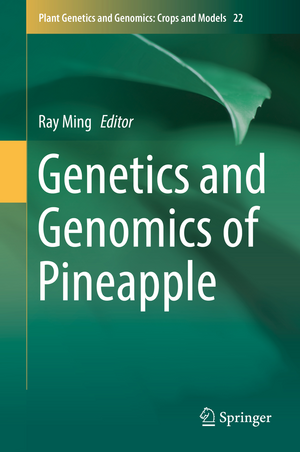Genetics and Genomics of Pineapple: Plant Genetics and Genomics: Crops and Models, cartea 22
Editat de Ray Mingen Limba Engleză Hardback – 10 dec 2018
Din seria Plant Genetics and Genomics: Crops and Models
- 18%
 Preț: 967.40 lei
Preț: 967.40 lei - 18%
 Preț: 1240.47 lei
Preț: 1240.47 lei - 18%
 Preț: 1235.88 lei
Preț: 1235.88 lei - 18%
 Preț: 956.33 lei
Preț: 956.33 lei - 18%
 Preț: 1233.06 lei
Preț: 1233.06 lei - 18%
 Preț: 955.08 lei
Preț: 955.08 lei - 18%
 Preț: 1228.29 lei
Preț: 1228.29 lei - 18%
 Preț: 1121.13 lei
Preț: 1121.13 lei - 18%
 Preț: 1009.54 lei
Preț: 1009.54 lei - 18%
 Preț: 943.73 lei
Preț: 943.73 lei - 18%
 Preț: 948.92 lei
Preț: 948.92 lei - 18%
 Preț: 1234.14 lei
Preț: 1234.14 lei - 18%
 Preț: 2116.19 lei
Preț: 2116.19 lei - 18%
 Preț: 1221.69 lei
Preț: 1221.69 lei - 18%
 Preț: 1235.43 lei
Preț: 1235.43 lei - 9%
 Preț: 1007.66 lei
Preț: 1007.66 lei
Preț: 574.08 lei
Preț vechi: 717.59 lei
-20% Nou
Puncte Express: 861
Preț estimativ în valută:
109.85€ • 114.98$ • 91.43£
109.85€ • 114.98$ • 91.43£
Carte tipărită la comandă
Livrare economică 27 martie-02 aprilie
Preluare comenzi: 021 569.72.76
Specificații
ISBN-13: 9783030006136
ISBN-10: 3030006131
Pagini: 290
Ilustrații: XI, 281 p. 61 illus., 48 illus. in color.
Dimensiuni: 155 x 235 mm
Greutate: 0.64 kg
Ediția:1st ed. 2018
Editura: Springer International Publishing
Colecția Springer
Seria Plant Genetics and Genomics: Crops and Models
Locul publicării:Cham, Switzerland
ISBN-10: 3030006131
Pagini: 290
Ilustrații: XI, 281 p. 61 illus., 48 illus. in color.
Dimensiuni: 155 x 235 mm
Greutate: 0.64 kg
Ediția:1st ed. 2018
Editura: Springer International Publishing
Colecția Springer
Seria Plant Genetics and Genomics: Crops and Models
Locul publicării:Cham, Switzerland
Cuprins
Preface.- Introduction.- Origin and Domestication of Pineapple.- Biology of the Pineapple Plant.- The Phylogeny of the Family Bromeliaceae.- Genetic Diversity of Pineapple.- Molecular Genetic Map of Pineapple.- Genetic Transformation of Pineapple.- A Brief History of Pineapple Improvement.- Sequencing and Assembly of the F153 Pineapple Genome.- The Draft Genome of MD-2 Pineapple.- Comparative Genomics of Pineapple and Other Angiosperm Genomes.- Pineapple Repeat Database.- Identification of microRNA, phasiRNAs, and Their Targets in Pineapple.- Comparative Analysis of Transcription Factors in Pineapple.- Alternative Splicing Landscape in Pineapple.- Analysis of Genes Encoding Proteolytic Enzymes in Pineapple.- Genomics of Pineapple Disease Resistance Genes.- Carbon Flux and Carbohydrate Gene Families in Pineapple.- Pineapple DB: An Online Pineapple Bioinformatics Resource.- Molecular Markersin Pineapple.- Genomics of the Pineapple Systeine Protease Family Bromelain.- Gametophyte Self-incompatibility in Pineapple.- Circadian Clock Cis-elements in the Evolution of CAM Photosynthesis.- Genomic Relationships, Diversity, and Ancestry of Ananas taxa.- Index.
Notă biografică
Dr. Ray Ming is a professor in the department of plant biology at the University of Illinois at Urbana-Champaign, Champaign, IL, USA. His research interests include studying sex chromosomes and sex determination in papaya, the origin and evolution of CAM photosynthesis in pineapple, and genome evolution in autopolyploid sugarcane.
Textul de pe ultima copertă
This book is the first comprehensive volume on the genetics and genomics of pineapple and provides an overview of the current state of pineapple research. Pineapple [Ananas comosus (L.) Merr.] is the second most important tropical fruit after banana in term of international trade. Its features are advantageous for genomic research: it has a small genome of 527 Mb which is diploid and vegetatively propagated; it is monocot, closely related to the grass family that includes major cereal crops, wheat, rice, corn, sorghum, and millet; and it serves as an out group for genetic and genomic research in grasses. In addition to exploring the evolution and improvement of pineapple, this work examines the pineapple genome with respect to genome structure and organization, comparative analyses with other angiosperm genomes, transcription factors, disease resistance, and circadian clock regulation of CAM related genes. With chapters covering botanical, genetic, genomic, and applied aspects ofpineapple, this text also encourages the application of genomic technologies and suggests future prospects.
Caracteristici
Enriches understanding of the current state of pineapple research as the only complete book available on the genetics and genomics of pineapple Combines material from all major global researchers who have been working on pineapple Equips readers with protocols for growing and transforming pineapple
